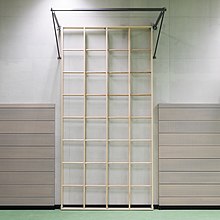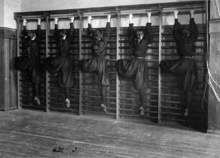Wall bars
As Sprossenwand a is ladder-shaped sports device for climbing referred to, which is attached to a room or hall wall.
It was developed by Pehr Henrik Ling (1776–1839) and further developed by his son Hjalmar Ling (1820–1886).
Appearance and texture
In gyms , the wall bars can usually be extended so that they can be climbed over or through from both sides. Depending on the nature of the wall bars, the height is between 210 and 260 cm and the number of bars is from 9 to 16. The top rung is always set in front of it so that gymnastic exercises can be performed by hanging on it.
A larger rung spacing is provided in the upper part of the rung ladder to enable climbing through. Such a distance is sometimes found in the lower quarter.
The wall bars available in stores are made of pine wood , the bars themselves are made of tougher ash wood . The rung thickness is about 35 mm.
Exercises
In addition to climbing, hanging and swinging the body on wall bars, these are also used in school gyms to hang long benches on them (balance and slide), to stretch ropes in between when the walls are unfolded and as a height-adjustable jumping-off point on a mat .
literature
- Heinz-Willi Gerards: Exercises on the wall bars. In: The trainer. Vol. 15, No. 3, ISSN 0342-8419 , 1982, p. 9.
- Rolf Nagel, Bettina Hauschild: Introduction of sport climbing on wall bars. In: Sportpraxis. Vol. 40, No. 2, 2000, ISSN 0176-5906 , pp. 6-7.
- Elburg Riz: Upstairs - downstairs on the wall bars. In: . Vol. 61, No. 4, 1987, ISSN 0344-4023 , p. 77.
Web links
Individual evidence
- ^ Encyclopedia Americana. Volume 30: Index. International Edition. Scholastic Library Publishing, Danbury CT 2006, ISBN 0-7172-0139-2 , p. 644.
- ↑ http://www.skibezirk-stuttgart.de/sp-history/files/1grundlagen/sportgeschichte.pdf ( page no longer available , search in web archives ) Info: The link was automatically marked as defective. Please check the link according to the instructions and then remove this notice.


